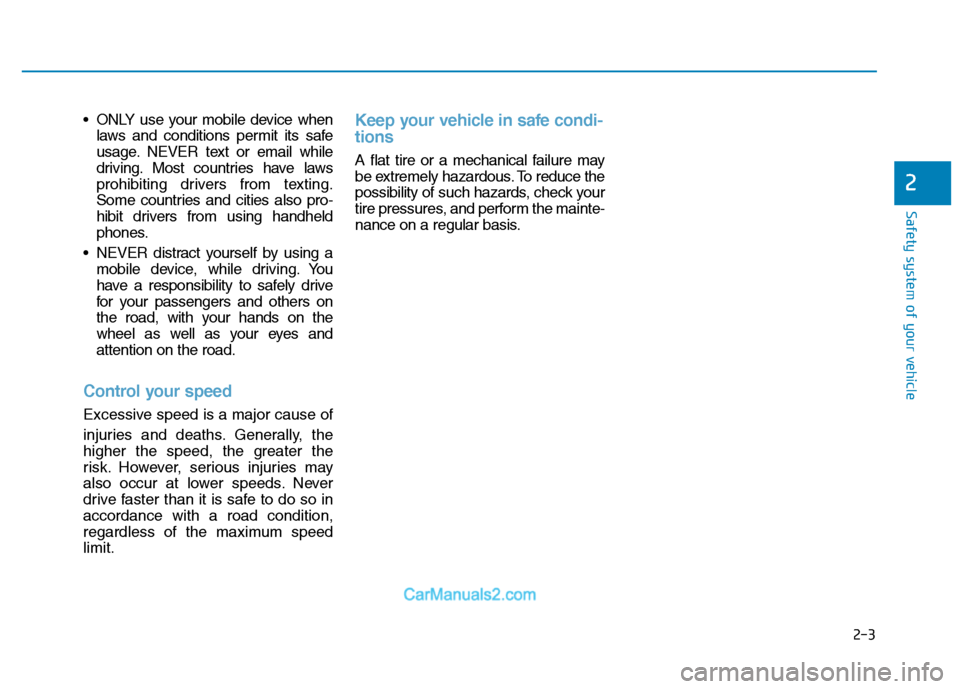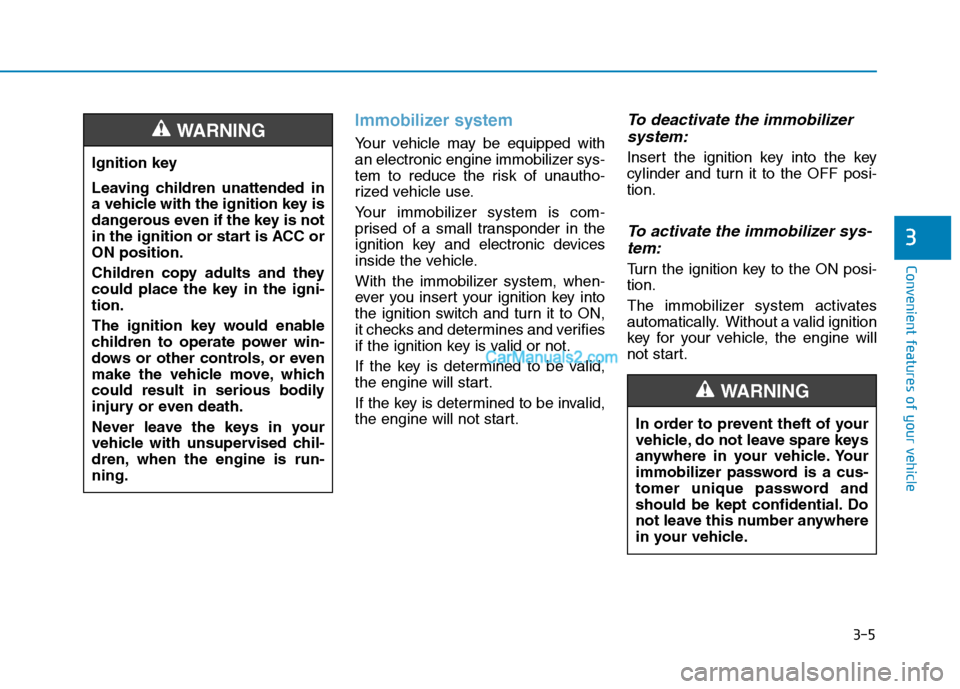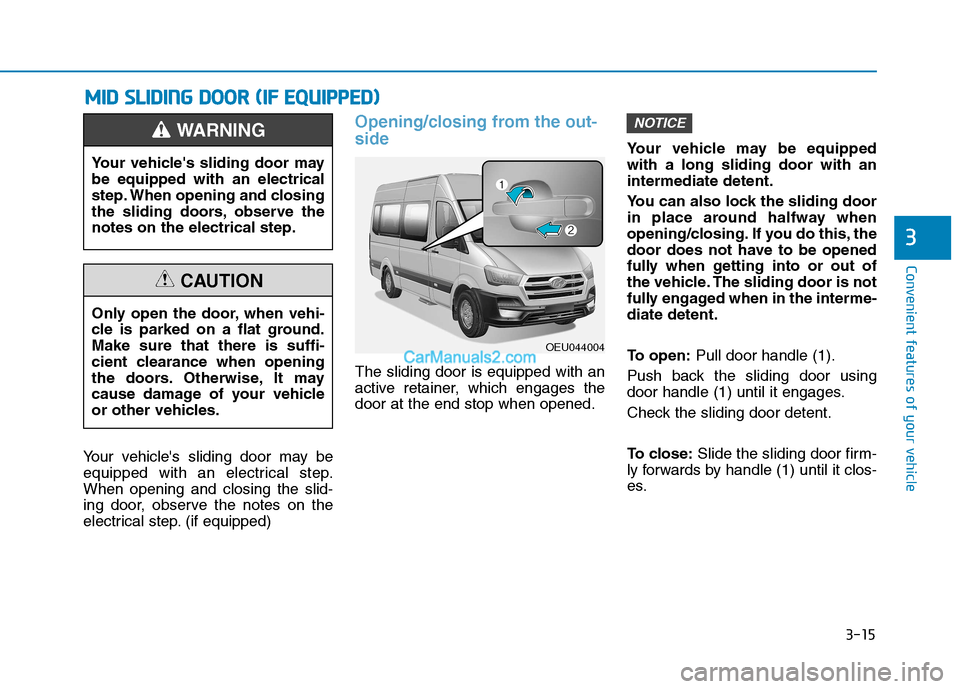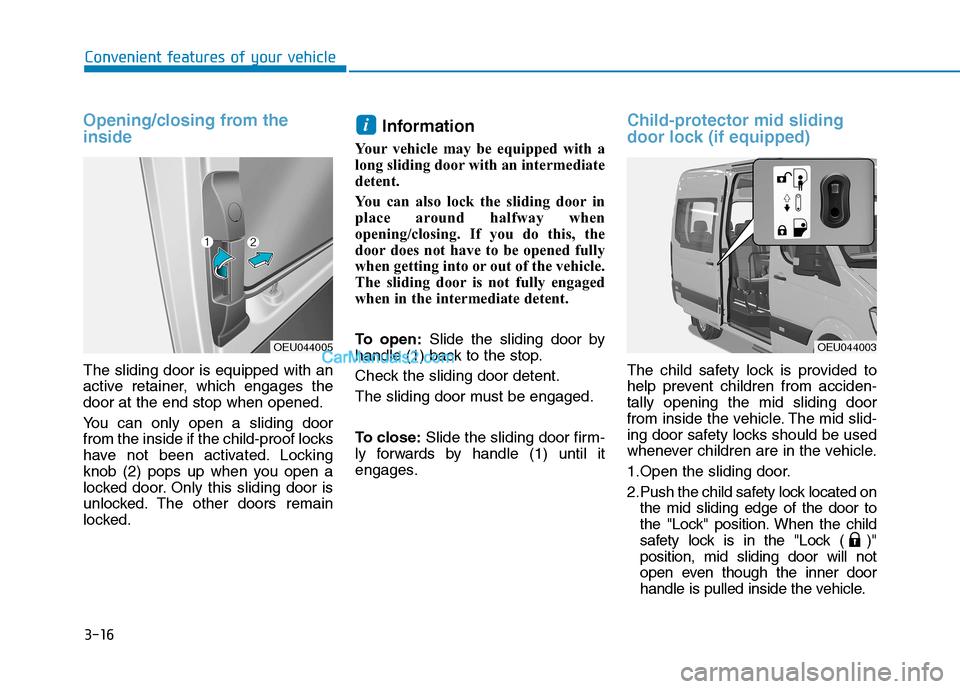2016 Hyundai H350 check
[x] Cancel search: checkPage 23 of 473

2-3
Safety system of your vehicle
ONLY use your mobile device whenlaws and conditions permit its safe
usage. NEVER text or email while
driving. Most countries have laws
prohibiting drivers from texting.
Some countries and cities also pro-
hibit drivers from using handheld
phones.
NEVER distract yourself by using a mobile device, while driving. You
have a responsibility to safely drive
for your passengers and others on
the road, with your hands on the
wheel as well as your eyes andattention on the road.
Control your speed
Excessive speed is a major cause of
injuries and deaths. Generally, the
higher the speed, the greater the
risk. However, serious injuries may
also occur at lower speeds. Never
drive faster than it is safe to do so inaccordance with a road condition,
regardless of the maximum speedlimit.
Keep your vehicle in safe condi- tions
A flat tire or a mechanical failure may
be extremely hazardous. To reduce the
possibility of such hazards, check your
tire pressures, and perform the mainte-
nance on a regular basis.
2
Page 38 of 473

2-18
Safety system of your vehicle
To release the seat belt:
The metal tap is released upon
pressing the release button (1) on
the buckle. When it is released, the seat belt is
automatically retracted back into the
retractor. When the metal tap is not released,
check the belt whether it is twisted or
not. Then, try it again.
2 point static belt
(for rear passengers)
To fasten your belt
To fasten the 2-point static belt,
insert the metal tab (1) into the buck-
le (2). There will be a "clicking"
sound, when the metal tab is locked
into the buckle. Make sure the seat
belt is securely locked and that theseat belt is not twisted.
To release the seat belt
The metal tap is released upon
pressing the release button (1) on
the buckle. When it is released, the seat belt is
automatically retracted back into the
retractor. When the metal tap is not released,
check the belt whether it is twisted or
not. Then, try it again.
ODH033057OEU034030
OEU034029
Page 42 of 473

2-22
Safety system of your vehicle
Seat belt precautionsLarger children
Children who are too large for child
restraint systems should always sit in
a rear seat and use the available
lap/shoulder belts. The lap belt
should be fastened as low and snug-
gly as possible across the hips.
Frequently check the belt tightness.
A child's squirming may move the
belt out of position. Children are
afforded the most safety in the event
of an accident when they are
restrained by a proper restraint sys-
tem in a rear seat. When a large child
(at the age of 13 and over) must beseated in the front seat, the child
should be securely restrained by the
available lap/shoulder belt, and theseat should be placed in the rear-
most position. Children at the age of
12 and under should be restrained
securely in a rear seat. NEVER placea child at the age of 12 and under ina front seat.
NEVER place a rear facing child seat
in the front seat of a vehicle.When the shoulder belt is fastened
slightly across the child's neck or
face, move the child closer to the
center of the vehicle. When the
shoulder belt is still fastened slightly
across their face or neck, they need
to be returned to a child restraint sys-tem.
All occupants of the vehicle
must and always fasten their
seat belts. Seat belts and childrestraints reduce the risk of
serious or fatal injury in the
event of a collision or sudden
stop. Without a seat belt, occu-
pants may slide too close to a
deploying air bag, strike the
interior structure or be thrown
out of the vehicle. Properly
worn seat belts greatly reduce
these hazards.
Always follow the precautions
of this manual, about seat belts,
air bags and occupant seats.
WARNING
Shoulder belts on small chil- dren
Never fasten a shoulder even
slightly across a child's neck
or face, when the vehicle is inmotion.
When seat belts are improper-
ly fastened over children,there is a risk of death or seri-
ous injury.
WARNING
Page 48 of 473

2-28
Never place a rear-facing child
restraint in the front passenger’s
seat. If the air bag deploys, it would
impact the rear-facing child restraint,
causing serious or fatal injury.
In addition, do not place front-facing
child restraints in the front passen-
ger’s seat either. If the front passen-
ger air bag inflates, it would cause
serious or fatal injuries to the child.
Air bag warning light
The purpose of the air bag warning
light on your instrument cluster is to
alert you of a potential problem with
your air bag - Supplemental
Restraint System (SRS). The warn-
ing light illuminates for approximately
6 seconds, after turning ON the igni-
tion switch. Then, it goes OFF.
Check the system for the below symptoms:
The light does not briefly illumi-
nate, after turning ON the ignition
switch.
The light remains ON longer than approximately 6 seconds.
The light remains ON, when the vehicle is in motion.
Safety system of your vehicle
NEVER use a rearward facing
child restraint on a seat pro-
tected by an ACTIVE AIRBAG
in front of it, DEATH or SERI-
OUS INJURY to the CHILD can
occur.
Never put a child restraint in
the front passenger’s seat. If
the front passenger air bag
inflates, it would cause seri-ous or fatal injuries.
WARNING
W7-147
Page 65 of 473

Convenient features of your vehicle
3
Interior light........................................................3-106Map lamp.........................................................................3-106
Reading lamp..................................................................3-107
Room lamp ......................................................................3-108
Cargo bed lamp..............................................................3-108
Rear step lamp...............................................................3-108
Defroster .............................................................3-109 Outside rearview mirror heater ................................3-109
Climate control system......................................3-110 Heating and air conditioning......................................3-111
Rear heating and air conditioning ............................3-116
System operation ..........................................................3-117
Fuel-fired heater ..........................................................3-119
Climate control air filter ..............................................3-119
Checking the amount of air conditioner refrigerant
and compressor lubricant ...........................................3-120
Windshield defrosting and defogging ............3-121 To defog inside windshield .........................................3-121
To defrost outside windshield ...................................3-122
Ceiling ventilator ................................................3-122
Storage compartment ........................................3-123 Overhead storage .........................................................3-123
Storage space above the headliner .........................3-124
Console storage.............................................................3-124
Glove box ........................................................................3-125 Sunglass holder .............................................................3-125
Interior features.................................................3-126 Cigarette lighter ............................................................3-126
Ashtray ............................................................................3-127
Cup holder.......................................................................3-127
Sunvisor ...........................................................................3-128
Power outlet ...................................................................3-128
Cargo bed (for van) ...........................................3-129 As the driver, you are responsible for ensuring
that: ..................................................................................3-129Luggage mass label ......................................................3-130
3
Page 67 of 473

3-5
Convenient features of your vehicle
Immobilizer system
Your vehicle may be equipped with
an electronic engine immobilizer sys-
tem to reduce the risk of unautho-
rized vehicle use.
Your immobilizer system is com-
prised of a small transponder in the
ignition key and electronic devices
inside the vehicle.
With the immobilizer system, when-
ever you insert your ignition key into
the ignition switch and turn it to ON,
it checks and determines and verifies
if the ignition key is valid or not.
If the key is determined to be valid,
the engine will start.
If the key is determined to be invalid,
the engine will not start.
To deactivate the immobilizersystem:
Insert the ignition key into the key
cylinder and turn it to the OFF posi-tion.
To activate the immobilizer sys-tem:
Turn the ignition key to the ON posi-tion.
The immobilizer system activates
automatically. Without a valid ignition
key for your vehicle, the engine will
not start.
3
Ignition key
Leaving children unattended in
a vehicle with the ignition key is
dangerous even if the key is not
in the ignition or start is ACC orON position.
Children copy adults and they
could place the key in the igni-tion.
The ignition key would enable
children to operate power win-
dows or other controls, or even
make the vehicle move, which
could result in serious bodily
injury or even death.
Never leave the keys in your
vehicle with unsupervised chil-
dren, when the engine is run-ning.
WARNING
In order to prevent theft of your
vehicle, do not leave spare keys
anywhere in your vehicle. Your
immobilizer password is a cus-
tomer unique password and
should be kept confidential. Do
not leave this number anywhere
in your vehicle.
WARNING
Page 77 of 473

3-15
Convenient features of your vehicle
Your vehicle's sliding door may be
equipped with an electrical step.When opening and closing the slid-
ing door, observe the notes on the
electrical step. (if equipped)
Opening/closing from the out- side
The sliding door is equipped with an
active retainer, which engages thedoor at the end stop when opened.Your vehicle may be equippedwith a long sliding door with anintermediate detent.
You can also lock the sliding door
in place around halfway when
opening/closing. If you do this, the
door does not have to be opened
fully when getting into or out of
the vehicle. The sliding door is not
fully engaged when in the interme-diate detent.
To open:
Pull door handle (1).
Push back the sliding door using
door handle (1) until it engages.
Check the sliding door detent.
To close: Slide the sliding door firm-
ly forwards by handle (1) until it clos-
es.
NOTICE
3
Your vehicle's sliding door may be equipped with an electrical
step. When opening and closing
the sliding doors, observe thenotes on the electrical step.
WARNING
MM IIDD SS LLIIDD IINN GG DD OO OORR (( IIFF EE QQ UUIIPP PPEEDD ))
Only open the door, when vehi-
cle is parked on a flat ground.Make sure that there is suffi-
cient clearance when opening
the doors. Otherwise, It may
cause damage of your vehicle
or other vehicles.
CAUTION
OEU044004
Page 78 of 473

3-16
Opening/closing from the inside
The sliding door is equipped with an
active retainer, which engages thedoor at the end stop when opened.
You can only open a sliding door
from the inside if the child-proof locks
have not been activated. Locking
knob (2) pops up when you open a
locked door. Only this sliding door is
unlocked. The other doors remain
locked.Information
Your vehicle may be equipped with a
long sliding door with an intermediate
detent.
You can also lock the sliding door in
place around halfway when
opening/closing. If you do this, the
door does not have to be opened fully
when getting into or out of the vehicle.
The sliding door is not fully engaged
when in the intermediate detent.
To open: Slide the sliding door by
handle (1) back to the stop.
Check the sliding door detent.
The sliding door must be engaged.
To close: Slide the sliding door firm-
ly forwards by handle (1) until it
engages.
Child-protector mid sliding
door lock (if equipped)
The child safety lock is provided to
help prevent children from acciden-tally opening the mid sliding door
from inside the vehicle. The mid slid-
ing door safety locks should be used
whenever children are in the vehicle.
1.Open the sliding door.
2.Push the child safety lock located on the mid sliding edge of the door to
the "Lock" position. When the child
safety lock is in the "Lock ( )"position, mid sliding door will not
open even though the inner door
handle is pulled inside the vehicle.
i
Convenient features of your vehicle
OEU044005OEU044003